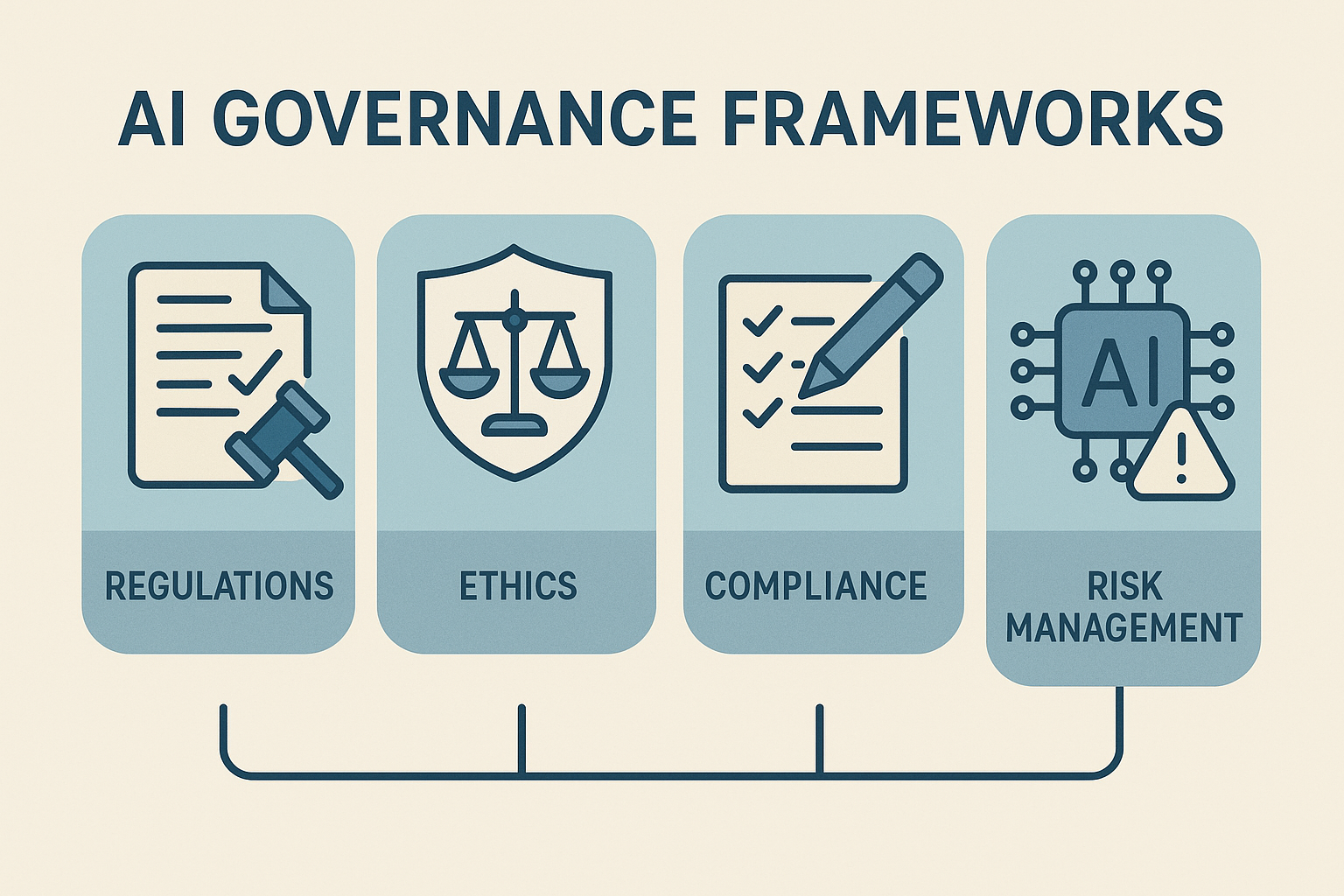
As artificial intelligence becomes deeply embedded in business operations worldwide, organizations face mounting pressure to implement robust AI governance frameworks. Recent studies show that 41% of organizations have experienced AI-related privacy breaches or security incidents, highlighting the critical need for structured oversight. The rapid adoption of AI technologies across industries has created an urgent demand for responsible AI practices that balance innovation with ethical considerations and regulatory compliance.
AI governance represents the comprehensive system of policies, procedures, and controls that guide the ethical development, deployment, and management of artificial intelligence systems throughout their lifecycle. This framework ensures that AI technologies operate transparently, fairly, and safely while delivering measurable business value. Organizations that establish strong governance foundations not only mitigate risks but also build stakeholder trust and accelerate AI adoption across their operations.
The stakes for proper AI governance have never been higher. From healthcare diagnostics to financial services and criminal justice applications, AI systems influence critical decisions affecting millions of lives daily. Without adequate oversight, these systems can perpetuate biases, violate privacy rights, and create unintended consequences that damage both individuals and organizations. This comprehensive guide outlines five essential steps that organizations must take to establish effective AI governance frameworks that promote trustworthy AI while supporting business objectives.
Step 1: Establish Leadership and Governance Structure
Building Cross-Functional AI Governance Teams
The foundation of effective AI governance begins with establishing clear leadership and organizational structure. Organizations must create dedicated governance bodies that bring together diverse expertise from across the enterprise. This cross-functional approach ensures that AI oversight incorporates technical, legal, ethical, and business perspectives into decision-making processes.
Chief Information Security Officers (CISOs), compliance officers, risk managers, and CTOs play central roles in defining the AI governance framework and setting strategic priorities. These leaders must collaborate closely with data scientists, IT teams, legal advisors, and other stakeholders to ensure the framework remains practical, effective, and aligned with regulatory requirements. The best governance structures operate through shared responsibility, where each department understands its role in upholding the framework.
Defining Roles and Responsibilities
Clear accountability structures form the backbone of successful AI risk management. Organizations should establish specific roles such as:
- Data stewards responsible for data quality and protection
- Algorithm auditors who regularly review AI systems for performance and ethical alignment
- Compliance officers ensuring AI use meets regulatory standards
- AI ethics committees providing oversight on moral and societal implications
Each role must have clearly defined responsibilities, reporting relationships, and decision-making authority. This structured approach prevents gaps in oversight while ensuring someone remains accountable for every aspect of AI system performance and compliance.
Creating Cultural Commitment
Leadership commitment extends beyond formal structures to encompass organizational culture. Leaders must actively demonstrate support for ethical AI development and ensure these principles permeate throughout the organization. This involves regular communication about AI governance priorities, recognition of teams that exemplify responsible practices, and integration of ethical considerations into performance evaluations and business processes.
Step 2: Conduct Comprehensive AI Inventory and Risk Assessment
Identifying All AI Systems and Applications
The second critical step involves conducting a thorough audit to inventory every AI tool and model in use across the organization. This comprehensive assessment must include both officially sanctioned systems and shadow AI applications that may operate without formal oversight. Organizations often discover numerous AI tools deployed across different business units, making centralized visibility challenging but essential.
AI inventory management requires systematic documentation of each system’s purpose, data sources, performance metrics, and associated risks. Organizations should capture detailed metadata including model development history, training data characteristics, deployment environments, and current usage patterns. This information forms the foundation for risk-based AI governance approaches that prioritize oversight based on potential impact.
Conducting Risk-Based Assessments
Not all AI systems carry equal risk, making risk stratification essential for efficient governance. Organizations should evaluate systems based on factors such as:
- Decision impact: Systems affecting critical business processes or individual rights require higher oversight
- Data sensitivity: Applications processing personal or confidential information need enhanced protection
- Regulatory exposure: Systems subject to specific compliance requirements demand specialized controls
- Technical complexity: More sophisticated AI models often require additional transparency and explainability measures
NIST AI Risk Management Framework provides excellent guidance for conducting these assessments. Organizations should develop standardized evaluation criteria that enable consistent risk categorization across all AI applications. This systematic approach ensures that governance resources focus on areas with the greatest potential for harm or regulatory violation.
Establishing Monitoring and Documentation Standards
Comprehensive documentation standards support ongoing AI governance effectiveness. Organizations must establish clear requirements for maintaining records throughout the AI lifecycle, including development decisions, testing results, deployment parameters, and performance monitoring data. This documentation proves essential for regulatory compliance, audit requirements, and incident investigation.
AI monitoring systems should track key performance indicators related to accuracy, fairness, security, and ethical alignment. Automated monitoring tools can help organizations scale their oversight capabilities while ensuring consistent evaluation across multiple AI systems. Regular reporting mechanisms keep leadership informed about governance status and emerging risks.
Also Read: Step-by-Step Guide to IoT Integration with AI In 2024
Step 3: Develop Comprehensive AI Policies and Standards
Creating Ethical Guidelines and Principles
The third step focuses on developing clear policies that outline acceptable AI use, model development standards, and responsible data practices. These policies must address core ethical principles including fairness, transparency, accountability, privacy protection, and human oversight. Organizations should tailor their guidelines to reflect industry-specific requirements and organizational values while ensuring alignment with emerging regulatory frameworks.
AI ethics policies should provide practical guidance for technical teams and business leaders facing real-world implementation decisions. Rather than abstract principles, effective policies include specific requirements such as bias testing procedures, data minimization practices, consent management protocols, and explainability standards. Clear examples and decision trees help teams apply ethical guidelines consistently across different scenarios.
Implementing Data Governance Protocols
Strong data governance forms the foundation of responsible AI development. Organizations must establish protocols for managing data lineage, user rights, and sensitive information handling throughout the AI lifecycle. These protocols should address data collection methods, quality standards, storage requirements, access controls, and retention policies.
Data governance for AI requires special attention to training data characteristics, including representativeness, bias potential, and legal compliance. Organizations should implement data validation procedures, documentation requirements, and audit trails that support both technical performance and regulatory compliance. Privacy-preserving techniques such as data anonymization and differential privacy may be necessary for certain applications.
Establishing Technical Standards
Technical standards ensure consistent AI development practices across the organization. These standards should cover model development methodologies, testing procedures, documentation requirements, and deployment protocols. Organizations may adopt established frameworks such as ISO/IEC 42001 or develop customized standards that reflect their specific needs and risk profile.
AI technical standards should address areas including:
- Model validation and testing procedures
- Explainability and interpretability requirements
- Security and privacy protection measures
- Performance monitoring and maintenance protocols
- Version control and change management processes
Clear technical standards enable teams to develop AI systems that meet governance requirements while maintaining development efficiency and innovation capacity.
Step 4: Implement Monitoring, Testing, and Compliance Procedures
Establishing Continuous Monitoring Systems
The fourth step involves implementing robust AI monitoring and testing procedures that ensure ongoing compliance with governance requirements. Continuous monitoring enables organizations to detect and address issues such as algorithmic bias, data drift, performance degradation, and security vulnerabilities before they cause significant harm.
Organizations should implement structured testing schedules that prioritize high-risk systems while maintaining oversight across all AI applications. Automated monitoring tools can track key metrics including accuracy rates, fairness indicators, security events, and compliance status. These systems should generate alerts when performance falls outside acceptable parameters or when potential issues require human investigation.
Implementing Bias Detection and Mitigation
AI bias detection represents a critical component of ongoing governance. Organizations must implement systematic procedures for identifying and addressing algorithmic bias that could lead to discriminatory outcomes. This includes testing AI systems across different demographic groups, evaluating training data for representation gaps, and monitoring real-world performance for fairness indicators.
Bias mitigation strategies may include data augmentation, algorithm adjustments, post-processing techniques, or human review procedures. Organizations should document their bias detection methods, establish acceptable thresholds, and maintain records of mitigation actions taken. Regular fairness audits help ensure that bias reduction efforts remain effective over time.
Ensuring Third-Party Vendor Compliance
Many organizations rely on third-party AI systems, creating additional governance challenges. Vendor risk management requires comprehensive evaluation procedures that assess AI suppliers for ethical practices, transparency, and compliance capabilities. Organizations should develop standardized questionnaires and audit procedures for evaluating third-party AI systems.
Third-party AI governance should include ongoing performance monitoring, contract requirements for compliance reporting, and regular reviews of vendor practices. Organizations must ensure that external AI systems meet the same governance standards as internal applications while maintaining visibility into potential risks and compliance issues.
Step 5: Ensure Ongoing Compliance and Continuous Improvement
Maintaining Regulatory Alignment
The final step focuses on ensuring ongoing AI compliance with evolving regulatory requirements and maintaining continuous improvement of governance practices. The AI regulatory landscape continues to develop rapidly, with new requirements emerging from jurisdictions worldwide. Organizations must establish processes for monitoring regulatory changes and updating their governance frameworks accordingly.
AI compliance management requires regular assessment of current practices against applicable regulations such as the EU AI Act, GDPR, and industry-specific requirements. Organizations should conduct periodic compliance audits, engage with legal experts familiar with AI regulations, and participate in industry groups that track regulatory developments.
Implementing Feedback and Improvement Mechanisms
Continuous improvement processes ensure that AI governance frameworks evolve with changing technology, business needs, and regulatory requirements. Organizations should establish regular review cycles that evaluate governance effectiveness, identify areas for enhancement, and implement necessary updates.
Feedback mechanisms should include input from multiple stakeholders including technical teams, business users, compliance officers, and external auditors. AI governance metrics such as incident rates, compliance scores, and stakeholder satisfaction provide objective measures of framework effectiveness. Regular surveys and feedback sessions help identify practical challenges and improvement opportunities.
Staying Current with Best Practices
The field of AI governance continues to evolve rapidly, with new tools, techniques, and best practices emerging regularly. Organizations should invest in ongoing education and training to ensure their teams remain current with latest developments. This includes participation in professional organizations, attendance at industry conferences, and engagement with academic research.
AI governance training programs should cover both technical and ethical aspects of responsible AI development. Regular training updates help ensure that all team members understand current requirements and can apply governance principles effectively in their daily work. Cross-functional training promotes better collaboration and shared understanding of governance objectives.
External Resources and Standards
Organizations implementing AI governance frameworks can benefit from several authoritative resources and standards. The NIST AI Risk Management Framework provides comprehensive guidance for managing AI-related risks across the system lifecycle. This framework offers practical tools and methodologies that organizations can adapt to their specific needs and risk profiles.
The Partnership on AI brings together leading technology companies, civil society organizations, and academic institutions to develop best practices for responsible AI development. Their research and publications provide valuable insights into emerging governance challenges and effective mitigation strategies.
Conclusion
Implementing effective AI governance requires a systematic approach that balances innovation with responsibility, compliance, and ethical considerations. These five key steps provide organizations with a comprehensive framework for establishing trustworthy AI systems that deliver business value while minimizing risks. From building strong leadership structures and conducting thorough risk assessments to developing clear policies and maintaining ongoing compliance, each step contributes to a robust governance foundation. Organizations that invest in comprehensive AI governance frameworks position themselves to capitalize on AI opportunities while building stakeholder trust and ensuring long-term sustainability. As the AI landscape continues to evolve, those with strong governance capabilities will be best positioned to adapt to new challenges and requirements while maintaining their competitive advantages.










